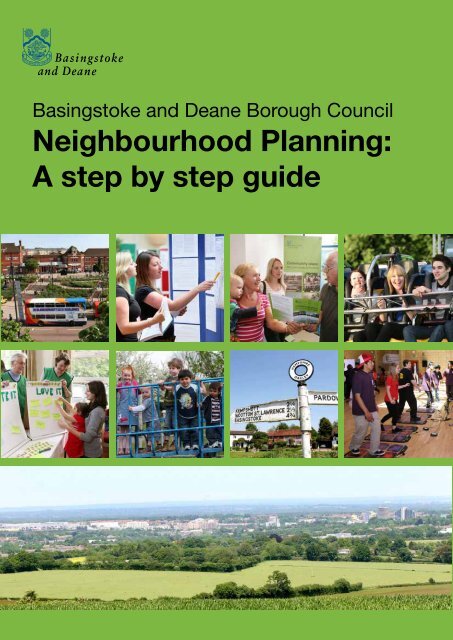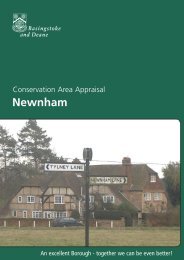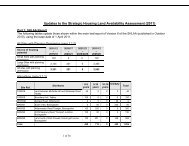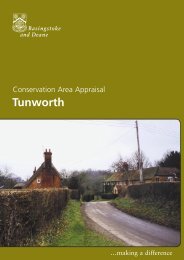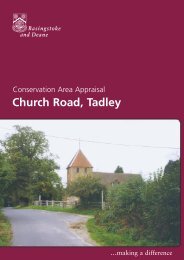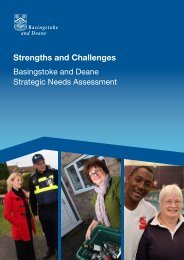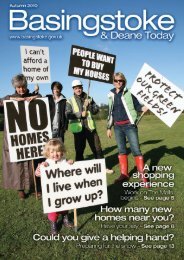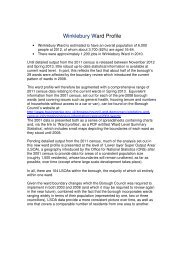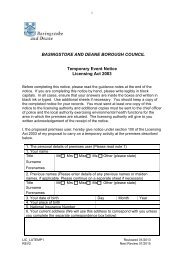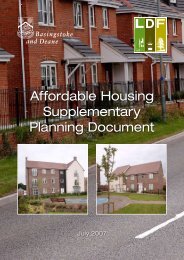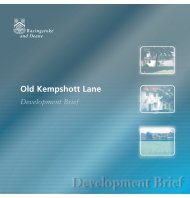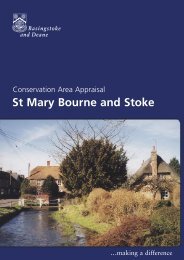Neighbourhood Planning: A step by step guide - Basingstoke and ...
Neighbourhood Planning: A step by step guide - Basingstoke and ...
Neighbourhood Planning: A step by step guide - Basingstoke and ...
You also want an ePaper? Increase the reach of your titles
YUMPU automatically turns print PDFs into web optimized ePapers that Google loves.
<strong>Basingstoke</strong> <strong>and</strong> Deane Borough Council<br />
<strong>Neighbourhood</strong> <strong>Planning</strong>:<br />
A <strong>step</strong> <strong>by</strong> <strong>step</strong> <strong>guide</strong>
<strong>Basingstoke</strong> <strong>and</strong> Deane<br />
Borough Council<br />
<strong>Neighbourhood</strong> <strong>Planning</strong>:<br />
A <strong>step</strong> <strong>by</strong> <strong>step</strong> <strong>guide</strong><br />
<strong>Basingstoke</strong> <strong>and</strong> Deane Borough Council encourages<br />
all local communities in the borough to get involved in<br />
shaping their local areas, <strong>and</strong> supports communities across<br />
the borough’s towns <strong>and</strong> villages to develop their own<br />
community-led plans.<br />
<strong>Neighbourhood</strong> planning is a new way for communities<br />
to decide the future shape of the places where they live<br />
<strong>and</strong> work. It has been introduced through the Localism Act,<br />
<strong>and</strong> the regulations came into force in April 2012. In the past,<br />
communities have been encouraged to prepare community<br />
plans which have a wide remit <strong>and</strong> seek to tackle a range of<br />
social, economic <strong>and</strong> environmental issues. <strong>Neighbourhood</strong><br />
planning follows a more regulated process, <strong>and</strong> focuses on<br />
planning issues. The borough council can help you decide<br />
which route best fits what you want to achieve.<br />
The neighbourhood planning process enables local<br />
communities to have more say in where new houses,<br />
businesses, shops <strong>and</strong> community facilities should go in<br />
their local area. Communities cannot use neighbourhood<br />
planning to prevent new development of strategic sites<br />
allocated <strong>by</strong> the borough council. They can, however,<br />
influence the details such as how a development looks.<br />
<strong>Basingstoke</strong> <strong>and</strong> Deane Borough Council will help you<br />
through the process of neighbourhood planning <strong>by</strong> offering<br />
support <strong>and</strong> advice. The following <strong>guide</strong> outlines the key<br />
<strong>step</strong>s involved.
Define the group/ the neighbourhood<br />
In areas with a parish or town council, they will take the lead in neighbourhood planning<br />
<strong>and</strong> will act as your local representatives. If you are in an area without a parish or<br />
town council, you will need to form a group <strong>and</strong> apply to the borough council, as local<br />
planning authority, to be designated as a neighbourhood forum. In order to qualify, the<br />
group must have at least 21 members <strong>and</strong> be open to new members<br />
Whether as a parish/town council or a neighbourhood forum, you will then need to<br />
decide on the area which best represents your ‘neighbourhood’ <strong>and</strong> apply to the council<br />
for it to be designated as a neighbourhood area for the purposes of planning.<br />
The neighbourhood area can either cover the whole parish, or just part of it, but the<br />
boundaries for separate neighbourhood areas cannot overlap.<br />
The council, as local planning authority, checks whether the proposed area is<br />
appropriate <strong>and</strong> it will be designated unless there are valid planning reasons for it to be<br />
turned down<br />
Decide to prepare a neighbourhood plan or<br />
neighbourhood development order<br />
You can choose to create either a plan or a development order, or both.<br />
A neighbourhood plan can establish general planning policies for the development<br />
<strong>and</strong> use of l<strong>and</strong> in your neighbourhood. It can be detailed or general, depending on<br />
what local people want. You may wish to concentrate on a few policies only, which<br />
may be important to your particular area.<br />
A neighbourhood development order can grant permission for development you<br />
want to see in your area. It would allow particular development to go ahead without<br />
the need to apply for separate planning permission.<br />
Prepare the plan/ order<br />
Use evidence that is already in the public domain, along with evidence that you<br />
collect, potentially through early consultation, to prepare your plan. Guidance can be<br />
provided <strong>by</strong> the council on what information is needed <strong>and</strong> how to collect it.<br />
<strong>Neighbourhood</strong> plans <strong>and</strong> development orders must be generally in line with local<br />
<strong>and</strong> national planning policies as well as other laws such as EU <strong>and</strong> human rights<br />
legislation.<br />
Consult<br />
You must publicise the proposals to those who live <strong>and</strong> work in the <strong>Neighbourhood</strong><br />
Area <strong>and</strong> consult statutory consultees who may be affected.
Submit to council as local planning authority<br />
Once the plan is written, the council needs to check it against the legislation <strong>and</strong><br />
regulations. This check isn’t about saying whether the content is right or wrong,<br />
but about the consultation <strong>and</strong> procedure followed.<br />
Independent check<br />
If the plan meets the requirements, the council will then arrange an independent<br />
examination. This will look at how the plan/order fits against the local plan,<br />
national policies, <strong>and</strong> any adjoining neighbourhood plans.<br />
If the plan or order doesn’t meet the right st<strong>and</strong>ards, the examiner will recommend<br />
changes. The planning authority will then need to consider the examiner’s views<br />
<strong>and</strong> decide whether to make those changes.<br />
If the examiner recommends significant changes, then you may decide to consult<br />
the local community again before proceeding.<br />
Community Referendum<br />
If the plan passes the check, the council will arrange a referendum on the plan or<br />
order to ensure that the community has the final say on whether a neighbourhood<br />
plan or order comes into force.<br />
People living in the neighbourhood who are registered to vote in local elections<br />
will be entitled to vote in the referendum. The referendum can also go beyond the<br />
neighbourhood area if it would have significant impacts on other people near<strong>by</strong>.<br />
A simple majority of those that vote (i.e. more than 50%) is required in order for<br />
the plan or order to be brought into force.<br />
LPA adopts Plan or Order<br />
If the plan or order is approved <strong>by</strong> a majority at the local referendum, it will be adopted <strong>by</strong> the<br />
local authority.<br />
The neighbourhood plan will then carry legal weight <strong>and</strong> must be taken into account when<br />
considering planning applications in the neighbourhood.<br />
A neighbourhood order will grant planning permission for development that complies with the<br />
order, without the need for a separate planning application.<br />
If you would like further information or advice on neighbourhood planning, please contact<br />
Joanne Brombley at ldf@basingstoke.gov.uk<br />
8446_0712


